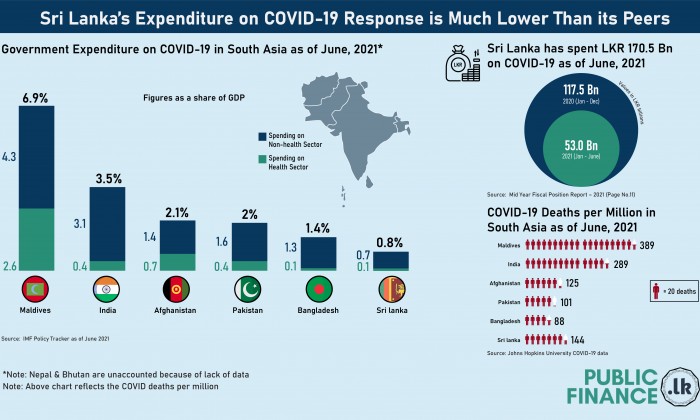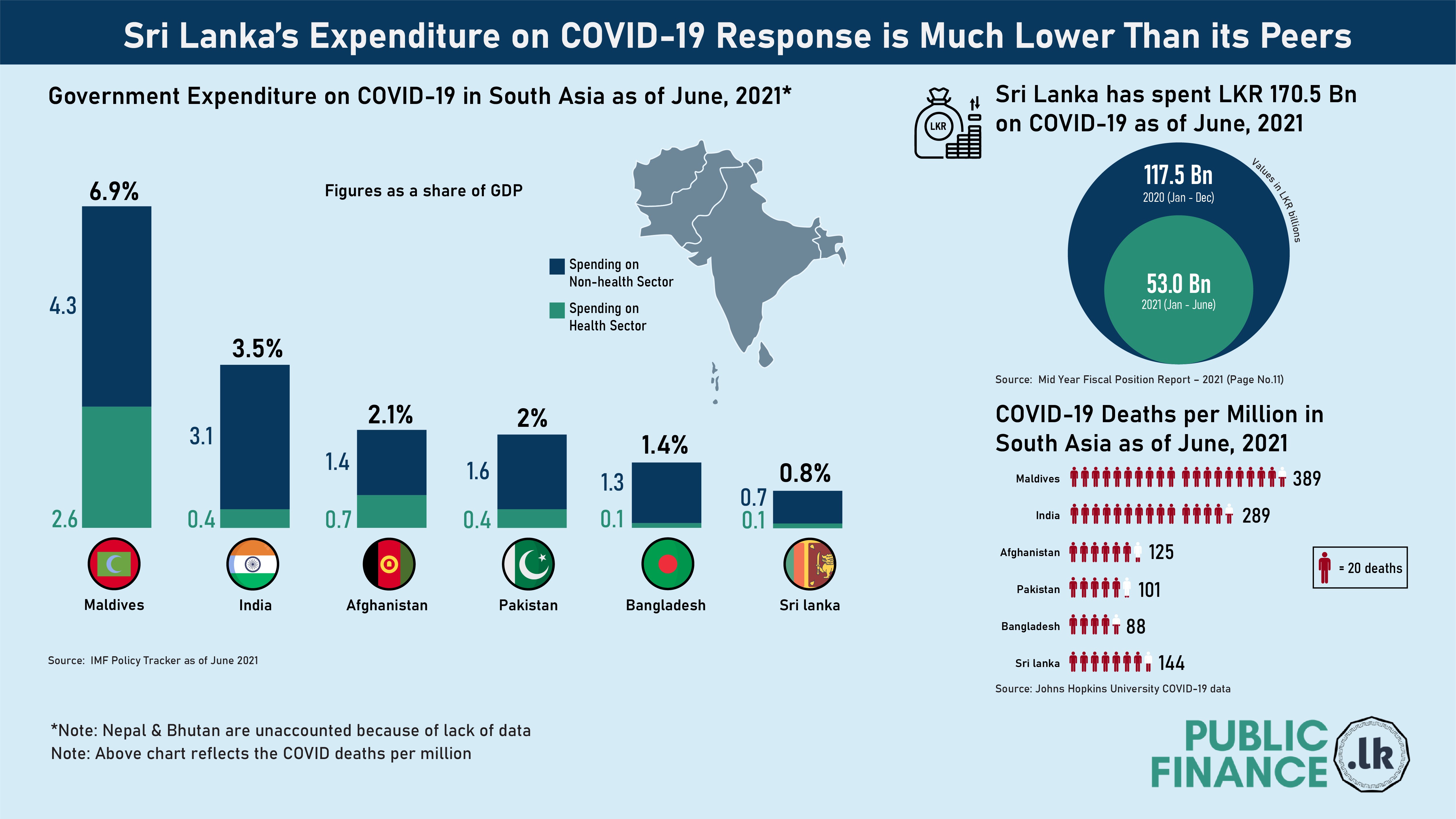According to Ministry of Finance, Sri Lanka has incurred a total of LKR 117.5 billion in 2020 and LKR 53.0 billion during Jan-June of 2021 as expenses on the country’s COVID-19 response.
According to data from the IMF Policy tracker, Sri Lanka’s expenditure on COVID-19 response is much lower than its South Asian peers. Other South Asian countries such as Maldives, India, Afghanistan, Pakistan, and Bangladesh have spent 1.4 percent, 2 percent, 2.1 percent, 3.5 percent and 6.9 percent of their GDP respectively on COVID-19 response as of June 2021. In contrast, Sri Lanka has spent only 0.8 percent of its GDP on the country’s COVID-19 response during the same period. This spending has been attributed to just 0.1 percent of GDP on health sector expenditure and 0.7 percent of GDP on non-health sector expenditure.
However, the severity of the Covid 19 has been mostly similar or even worse for Sri Lanka compared to other South Asian nations. The table below shows the number of COVID-19 cases and deaths per million as at 30 June 2021 and the death rate for the above mentioned South Asian countries as reported through data in https://ourworldindata.org/coronavirus
|
Country
|
Deaths per million
|
Cases per million
|
Death rate (Deaths/Cases)
|
|
Maldives
|
389
|
136,526
|
0.28%
|
|
India
|
289
|
22,037
|
1.31%
|
|
Sri Lanka
|
144
|
12,099
|
1.19%
|
|
Afghanistan
|
125
|
3,048
|
4.10%
|
|
Pakistan
|
101
|
4,339
|
2.33%
|
|
Bangladesh
|
88
|
5,545
|
1.59%
|
Source: Johns Hopkins University COVID-19 data
Details on Covid-19 Expenditure by each country
The Sri Lankan government has allocated up to 0.1 percent of GDP for containment measures, as well as USD 5 million (0.01 percent of GDP) to the SAARC COVID-19 Emergency Fund. Cash transfers to vulnerable groups amounted to around 0.6 percent of GDP in 2020 and around 0.1 percent of GDP as of June 2021.
In contrast, the COVID-19 responses of some of Sri Lanka’s regional peers were as follows:
- The government of Maldives increased the amount of funds allocated for the health sector and subsidized 40 percent and 30 percent of civilian’s electricity bills and water bills respectively for the months of April and May. In addition, they also gave special allowances to those who lost their jobs due to COVID-19.
- India spent on the following: In-kind items (food; cooking gas) and cash transfers to lower-income households (1.2 percent of GDP), wage support and employment provision to low-wage workers (0.5 percent of GDP) and insurance coverage for workers in the healthcare sector and healthcare infrastructure (0.1 percent of GDP).
- The Afghan government’s expenditure includes spending for urgent health needs, such as establishing testing labs, setting up special wards to boost hospitalization and care capacity and procuring critical medical supplies. From April-June 2020, the government also provided free bread to the poor in Kabul, later extending this to other cities. In May, it waived electricity bills of less than AFN 1,000 (USD 13) for families in Kabul for a period of two months and paid utility bills of the previous two months for 50 percent of households in Kabul. The authorities also rolled out about 0.8 percent of GDP for social assistance under the World Bank-funded REACH program in 2020, with the remaining 0.6 percent of GDP continuing in 2021.
- Pakistan provided a range of cash transfers for the following: PKR 75 billion to 6.2 million daily wage workers, PKR 150 billion to more than 12 million low-income families, PKR 100 billion to support SMEs and the agriculture sector in the form of power bill deferment, bank lending, as well as subsidies and tax incentives.
- In 2020, the Bangladesh government allocated BDT 21.3 billion (approximately USD 250.9 million) under a housing scheme for the homeless, BDT 15 billion (approximately USD 176.7 million) for the poor who faced job losses from the pandemic, BDT 7.5 billion (approximately USD 88.3 million) to provide health insurance for government employees most at risk, and BDT 1 billion (approximately USD 11.8 million) in bonus payments for public health workers treating COVID-19 patients. In January 2021, the government increased the COVID-19 Emergency Response and Pandemic Preparedness Project costs by BDT 56.6 billion (approximately USD 666.7 million) mostly reflecting the procurement, preservation, and distribution of vaccines.
Note: There is a small difference in the figure quoted by the IMF compared to the MoF’s estimate. The MoF’s figure, LKR 170 billion, as a share of 2020’s GDP amounts to 1.1% of GDP. Yet, much less than other South Asian countries used for the comparison.
Sources:
- Policy Responses to COVID-19: Policy Tracker, June 2021. https://www.imf.org/en/Topics/imf-and-covid19/Policy-Responses-to-COVID-19
- Ministry of Finance Sri Lanka, Mid-Year Fiscal Position Report – 2021
- Johns Hopkins University COVID-19 data. COVID-19 Data Explorer - Our World in Data



